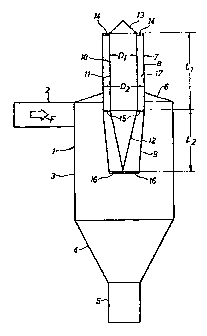Some of the information on this Web page has been provided by external sources. The Government of Canada is not responsible for the accuracy, reliability or currency of the information supplied by external sources. Users wishing to rely upon this information should consult directly with the source of the information. Content provided by external sources is not subject to official languages, privacy and accessibility requirements.
Any discrepancies in the text and image of the Claims and Abstract are due to differing posting times. Text of the Claims and Abstract are posted:
| (12) Patent: | (11) CA 2221613 |
|---|---|
| (54) English Title: | CYCLONE |
| (54) French Title: | CYCLONE |
| Status: | Expired and beyond the Period of Reversal |
| (51) International Patent Classification (IPC): |
|
|---|---|
| (72) Inventors : |
|
| (73) Owners : |
|
| (71) Applicants : |
|
| (74) Agent: | GOWLING WLG (CANADA) LLPGOWLING WLG (CANADA) LLP |
| (74) Associate agent: | |
| (45) Issued: | 2006-05-16 |
| (86) PCT Filing Date: | 1995-05-30 |
| (87) Open to Public Inspection: | 1996-12-05 |
| Examination requested: | 2002-03-19 |
| Availability of licence: | N/A |
| Dedicated to the Public: | N/A |
| (25) Language of filing: | English |
| Patent Cooperation Treaty (PCT): | Yes |
|---|---|
| (86) PCT Filing Number: | PCT/SE1995/000607 |
| (87) International Publication Number: | WO 1996038231 |
| (85) National Entry: | 1997-11-19 |
| (30) Application Priority Data: | None |
|---|
A cyclone for treating a gas flow (F) containing dust comprises a cyclone
chamber (1) of circular cross section and having a vertical axis, and a
central tube
(7) of circular cross section, which is coaxially arranged in the upper
portion of the
cyclone chamber (1). An elongate insert element (10), which is vertically
inserted
in the central tube (7), is so designed and extends in such a manner downwards
in the central tube (7) from the upper end thereof that a circumferential gap
(17)
exists between the insert element (10) and the central tube (7). This gap (17)
has
a preferably constant cross-sectional area which does not increase in the
direction
of the gas flow.
Cyclone destiné au traitement d'un courant gazeux (F) contenant des poussières, comportant une chambre (1) de cyclone de section circulaire et pourvue d'un axe vertical, et un tube central (7) de section circulaire, disposé coaxialement dans la partie supérieure de la chambre (1) de cyclone. Un élément d'insertion (10) allongé, inséré verticalement dans le tube central (7), est conçu et s'étend de telle façon vers le bas dans ledit tube (7), à partir de l'extrémité supérieure de ce dernier, qu'il existe un espace circonférentiel (17) entre l'élément d'insertion (10) et le tube central (7). Cet espace (17) a une superficie de section de préférence constante qui n'augmente pas dans la direction du courant gazeux.
Note: Claims are shown in the official language in which they were submitted.
Note: Descriptions are shown in the official language in which they were submitted.

2024-08-01:As part of the Next Generation Patents (NGP) transition, the Canadian Patents Database (CPD) now contains a more detailed Event History, which replicates the Event Log of our new back-office solution.
Please note that "Inactive:" events refers to events no longer in use in our new back-office solution.
For a clearer understanding of the status of the application/patent presented on this page, the site Disclaimer , as well as the definitions for Patent , Event History , Maintenance Fee and Payment History should be consulted.
| Description | Date |
|---|---|
| Time Limit for Reversal Expired | 2015-06-01 |
| Letter Sent | 2014-05-30 |
| Grant by Issuance | 2006-05-16 |
| Inactive: Cover page published | 2006-05-15 |
| Inactive: IPC from MCD | 2006-03-12 |
| Inactive: Final fee received | 2006-02-28 |
| Pre-grant | 2006-02-28 |
| Notice of Allowance is Issued | 2006-02-14 |
| Letter Sent | 2006-02-14 |
| Notice of Allowance is Issued | 2006-02-14 |
| Inactive: Approved for allowance (AFA) | 2005-11-14 |
| Amendment Received - Voluntary Amendment | 2005-10-20 |
| Letter Sent | 2005-09-15 |
| Inactive: Single transfer | 2005-05-13 |
| Change of Address Requirements Determined Compliant | 2005-05-10 |
| Inactive: Office letter | 2005-05-10 |
| Revocation of Agent Request | 2005-04-27 |
| Appointment of Agent Request | 2005-04-27 |
| Inactive: S.30(2) Rules - Examiner requisition | 2005-04-20 |
| Inactive: S.29 Rules - Examiner requisition | 2005-04-20 |
| Letter Sent | 2002-04-24 |
| All Requirements for Examination Determined Compliant | 2002-03-19 |
| Request for Examination Requirements Determined Compliant | 2002-03-19 |
| Request for Examination Received | 2002-03-19 |
| Inactive: IPC assigned | 1998-02-25 |
| Inactive: First IPC assigned | 1998-02-25 |
| Classification Modified | 1998-02-25 |
| Letter Sent | 1998-02-11 |
| Inactive: Notice - National entry - No RFE | 1998-02-11 |
| Application Received - PCT | 1998-02-10 |
| Application Published (Open to Public Inspection) | 1996-12-05 |
There is no abandonment history.
The last payment was received on 2006-04-20
Note : If the full payment has not been received on or before the date indicated, a further fee may be required which may be one of the following
Please refer to the CIPO Patent Fees web page to see all current fee amounts.
Note: Records showing the ownership history in alphabetical order.
| Current Owners on Record |
|---|
| ANDRITZ TECHNOLOGY AND ASSET MANAGEMENT GMBH |
| Past Owners on Record |
|---|
| CLAES HALLDIN |
| HEIKKI SALO |
| LARS-ERIK JOHANSSON |